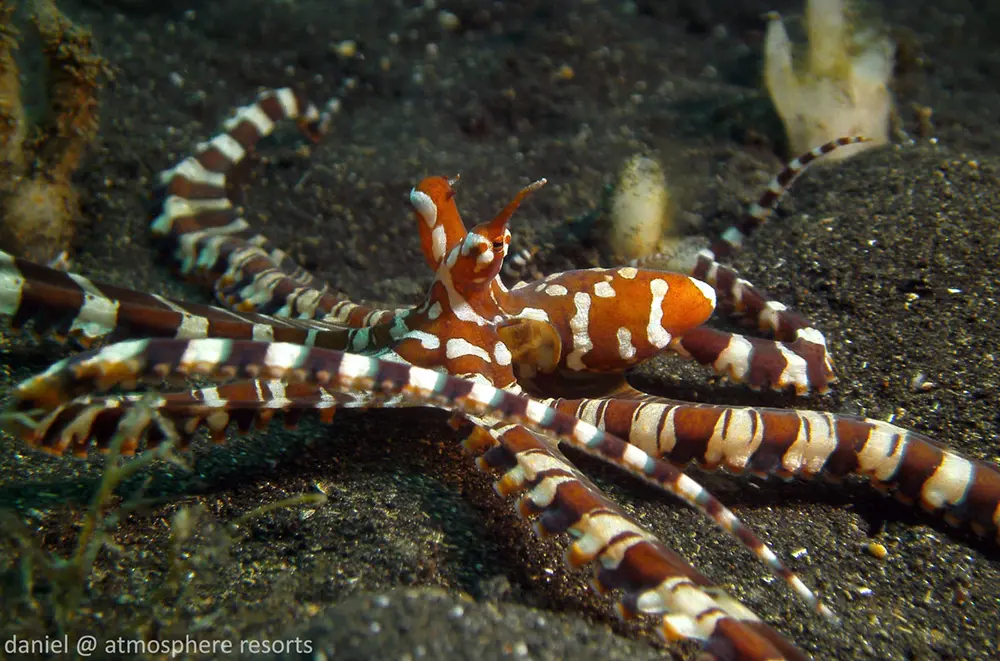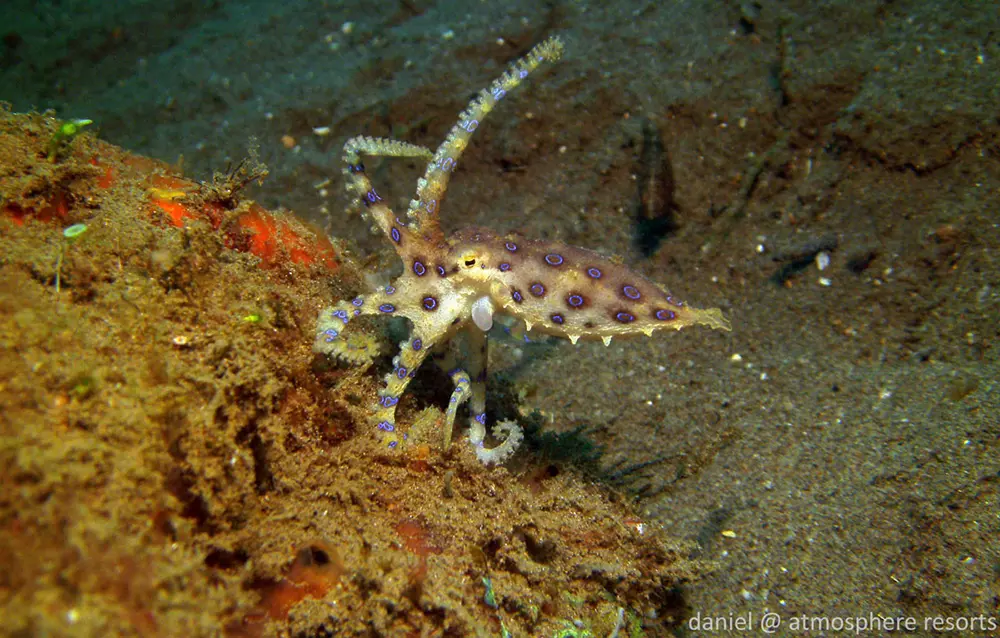When divers arrive at Atmosphere Resort, they usually come prepared with a list of the critters they want to see the most. Many of these ‘critter lists’ vary due to the sheer number of critters you can see along the Dauin coast. Some people prefer nudibranchs, some are in need of frogfish, but nearly all of our divers want the “Big Three.”
The “Big Three” are found almost exclusively in muck diving environments. What are they, you ask? Well, they are the most sought after octopus on the Dauin coast – the Mimic octopus, the Wonderpus and the Blue-ringed octopus. Although they are always a challenge to find due to their amazing ability to camouflage against their surroundings, these three octopus are a treat for any diver, photographer or not.

Here you can see the striking pattern of the Mimic Octopus. Notice the white base of the tentacles.
The Mimic octopus (Thaumoctopus mimicus) is one of the most fascinating critters in the ocean and can only be found in the Indo-Pacific in places like Indonesia, the Philippines, and occasionally on the Great Barrier Reef. It lives up to its name – this octopus has the ability to actually mimic the shapes and behaviors of other critters. It is the only known species in the ocean that can mimic the behavior of multiple species. It can mimic around 15 different species, including the banded sea krait, stingrays, and lionfish, just to name a few. It is also intelligent enough to mimic the species that will be a threat to whatever critter is getting too close. The Mimic octopus is not very big, only growing to a length of around 60 cm. They are usually brown but are more known for their striped patterns. They are often found in muddy areas at depths of around 10-20 meters, although they can be found as shallow as 3 meters at some of the dive sites in Dauin. We usually see Mimic octopus on the sandy slopes of Cars, Secret Corner, and The Pier.

The Wonderpus can be characterized by its long eye stalks and can even be identified by their spot patterns.
Easily confused with the Mimic octopus is the Wonderpus (Wunderpus photogenicus), an octopus with a very similar body pattern and shape that is also found only in the Indo-Pacific. The Wonderpus is usually more brown than the Mimic octopus, but colors can vary so that is not the best way to distinguish between the two. The Wonderpus has eyes on long stalks compared to the short stalks of the Mimic octopus. The Wonderpus is most active around dusk and dawn while the Mimic octopus is active during the day. One of the easiest ways to distinguish between the two species is looking at the base of the tentacles. The Wonderpus tentacle base has alternating colors that accompany the stripes while the Mimic octopus has a completely white base. This is sometimes hard to see if the octopus is only sticking its eyes out of a hole. The Wonderpus is a smaller octopus, growing between 15-25 cm and can be found at depths of around 5-25 meters. The white spots of the Wonderpus even differ between individuals so you can use photo identification to monitor different octopus in the area. We tend to see the Wonderpus at Secret Corner and The Pier.

This species can be well camouflaged in rubble, but when threatened, will show its pattern of blue rings to ward off potential threats.
The easiest species of the “Big Three” to identify, and also the smallest, would have to be the Blue-ringed octopus (Hapalochlaena lunulata), also found only in the Indo-Pacific. They are usually around 5 cm, with their arms reaching a length of 7 cm, and found at depths between 0-20 meters. If you picture the size of a golf ball, that’s about the same as a Blue-ringed octopus with its tentacles drawn close. It can be easily recognized by the flashing blue rings it exhibits when threatened. When resting or hiding, it can blend perfectly with its surroundings, usually sandy areas or rubble. Although it is a very docile creature, this octopus carries a powerful venom in its saliva called tetrodotoxin, a deadly neurotoxin that is extremely potent. We can find the Blue-ringed octopus at the following dive sites: San Miguel, Richard’s Point, The Pier, Secret Corner, and even the Atmosphere House Reef.
Dauin is a great place to visit if you are looking to find the Mimic octopus, Wonderpus, or Blue-ringed octopus. We even have a dive site, Secret Corner, where all three can be found. They are all great at camouflage and extremely hard to find, but if anyone can find them, it’s our dive guides. Next time you come visit us at Atmosphere, ask for the “Big Three” and we will try our hardest to help you check them off your list.
Your marine biologist /Daniel






